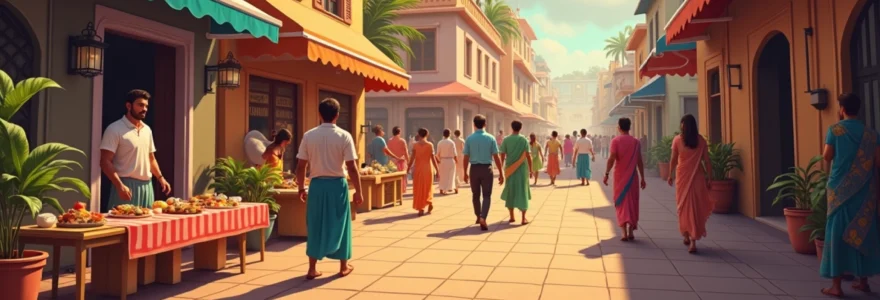Indian cuisine is a vibrant tapestry of flavours, aromas, and culinary traditions that have evolved over thousands of years. From the bustling streets of Mumbai to the opulent kitchens of royal palaces, the diversity of Indian food reflects the country’s rich cultural heritage and regional variations. This culinary journey takes us through the aromatic spice bazaars, sizzling street food stalls, and elegant dining halls, offering a taste of India’s gastronomic wonders.
Origins and regional diversity of indian cuisine
The roots of Indian cuisine can be traced back to ancient civilisations that flourished along the Indus Valley. Over millennia, the subcontinent’s culinary landscape has been shaped by a myriad of influences, including invasions, trade, and religious practices. This amalgamation has resulted in a mosaic of regional cuisines, each with its distinct flavour profiles and cooking techniques.
Northern India is known for its hearty, wheat-based dishes and the use of dairy products. The cuisine of this region has been heavily influenced by Mughal traditions, resulting in rich, creamy curries and tandoor-cooked meats. In contrast, Southern Indian cuisine relies heavily on rice, coconut, and seafood, with a penchant for spicier flavours and vegetarian options.
The eastern part of India, particularly Bengal, is famous for its love of fish and sweet dishes. Meanwhile, the western states like Gujarat and Maharashtra boast a unique blend of vegetarian delicacies and coastal specialities. This regional diversity ensures that travelling across India is as much a culinary adventure as it is a cultural one.
Street food delicacies across india
One cannot truly experience Indian cuisine without indulging in its vibrant street food culture. Each city and region boasts its own specialities, often reflecting local tastes and ingredients. Street food in India is not just about satisfying hunger; it’s a social experience, a way to connect with the local culture, and a testament to the country’s culinary ingenuity.
Mumbai’s vada pav and pav bhaji
Mumbai, the bustling financial capital of India, is renowned for its street food scene. The iconic vada pav , often dubbed the Indian burger, consists of a spicy potato fritter sandwiched between a soft bun, accompanied by fiery chutneys. It’s a perfect example of how Indian cuisine adapts to urban lifestyles without compromising on flavour.
Another Mumbai favourite is pav bhaji , a hearty dish of mashed vegetables cooked in a spicy tomato gravy, served with buttered bread rolls. This dish originated as a quick meal for textile mill workers but has since become a beloved street food staple across the country.
Delhi’s chaat culture: golgappa and aloo tikki
The streets of Delhi are a paradise for chaat lovers. Golgappa , also known as pani puri in other regions, is a crispy hollow puri filled with spicy tamarind water, chickpeas, and potatoes. It’s a burst of flavours that encapsulates the essence of Indian street food – tangy, spicy, and utterly addictive.
Aloo tikki , crispy potato patties served with an array of chutneys and yoghurt, is another Delhi speciality that showcases the city’s love for hearty, flavourful snacks. These street food delicacies are not just meals; they’re an integral part of Delhi’s culinary identity.
Kolkata’s kathi rolls and phuchka
Kolkata’s street food scene is a delightful mix of Bengali and Mughlai influences. The kathi roll , a paratha wrapped around kebabs, eggs, and spicy sauces, is a popular grab-and-go meal that originated in the city. It’s a perfect example of how Indian cuisine adapts to urban needs while maintaining traditional flavours.
Phuchka , Kolkata’s version of golgappa, is distinguished by its use of a spicy potato filling and tamarind water. The city’s street food culture is a testament to its cosmopolitan history and the Bengali love for bold flavours.
South indian street specialties: dosa and idli
Southern Indian street food offers a different palette of flavours and textures. The dosa , a crispy fermented rice and lentil crepe, is a versatile dish that can be enjoyed plain or stuffed with various fillings. Its popularity has spread far beyond South India, becoming a national favourite.
Idli , steamed rice cakes served with sambar and chutney, are a healthy and light option popular for breakfast or as a quick snack. These dishes showcase the South Indian preference for fermented batters and coconut-based accompaniments, offering a distinct contrast to North Indian street food.
Royal cuisines of india’s historical empires
While street food represents the heart of Indian cuisine, the royal kitchens of historical empires have contributed significantly to the country’s gastronomic heritage. These cuisines, developed in the courts of maharajas and emperors, are characterised by their rich ingredients, complex cooking techniques, and elaborate presentations.
Mughlai cuisine: biryani and kebab traditions
Mughlai cuisine, a legacy of the Mughal Empire, is synonymous with rich, aromatic dishes that blend Persian, Turkish, and Indian flavours. The iconic biryani , a fragrant rice dish layered with meat or vegetables and spices, is perhaps the most famous export of this culinary tradition. Slow-cooked in sealed pots, biryani epitomises the art of flavour infusion.
Kebabs, another Mughlai speciality, showcase the empire’s love for grilled meats. From the tender seekh kebab to the melt-in-your-mouth galouti kebab , these dishes demonstrate the sophisticated spice blends and cooking techniques that were developed in royal kitchens.
Rajputana culinary heritage: dal baati churma
The cuisine of Rajasthan, shaped by the region’s arid climate and warrior culture, is known for its hearty, long-lasting dishes. Dal baati churma , a combination of lentils, hard wheat rolls, and sweetened cereal, is a prime example of Rajputana culinary ingenuity. This dish was designed to provide sustenance during long military campaigns and has since become an integral part of Rajasthani cuisine.
Game meats and rich gravies are also hallmarks of Rajputana cuisine, reflecting the royal hunting traditions and the need to preserve food in a harsh climate. The use of dried fruits and nuts in savoury dishes is another distinctive feature, adding richness and texture to the cuisine.
Awadhi gastronomy: dum pukht and galouti kebab
Awadhi cuisine, originating from the kitchens of Nawabs in Lucknow, is renowned for its subtle flavours and refined cooking techniques. The dum pukht method, where food is slow-cooked in sealed containers, allows spices to infuse gently, resulting in aromatic and tender dishes.
The galouti kebab , a melt-in-your-mouth patty of minced meat, is said to have been created for a toothless Nawab. This dish exemplifies the Awadhi emphasis on texture and flavour, achieved through meticulous preparation and the use of aromatic spices.
Hyderabadi nizami delicacies: haleem and mirchi ka salan
Hyderabadi cuisine, influenced by the Nizams of Hyderabad, is a unique blend of Mughlai, Turkish, and local Telugu flavours. Haleem , a rich stew of lentils, wheat, and meat, is a signature dish that showcases the cuisine’s hearty yet refined character.
Mirchi ka salan , a spicy curry of green chillies in a peanut and sesame gravy, is another Hyderabadi speciality that demonstrates the cuisine’s bold flavour combinations. These dishes reflect the opulence of the Nizam’s court and the region’s love for robust, spicy flavours.
Spices and flavour profiles in indian cooking
At the heart of Indian cuisine lies its complex use of spices. The art of blending spices, or masala , is what gives Indian food its distinctive character. Each region has its own signature spice blends, reflecting local tastes and available ingredients.
Common spices in Indian cooking include:
- Turmeric: Known for its bright yellow colour and earthy flavour
- Cumin: Adds warmth and depth to dishes
- Coriander: Provides a citrusy note
- Cardamom: Offers a sweet, aromatic flavour
- Ginger: Adds a spicy, pungent kick
The use of these spices varies significantly across regions. Northern Indian cuisine tends to use dried spices, while southern cooking often incorporates fresh herbs and curry leaves. The coastal regions are known for their liberal use of coconut and tamarind, adding tangy and sweet notes to their dishes.
Understanding the role of spices is crucial in appreciating the complexity of Indian cuisine. Each dish is a carefully orchestrated symphony of flavours, where spices are not just added for heat, but to create layers of taste that unfold with each bite.
Vegetarian traditions in indian cuisine
India has a long and rich tradition of vegetarian cuisine, deeply rooted in religious and cultural practices. Many Hindus, Jains, and Buddhists follow vegetarian diets, leading to the development of a vast array of meat-free dishes that are both nutritious and flavourful.
Lentils, or dal , form the backbone of Indian vegetarian cuisine, providing a crucial source of protein. The variety of lentil dishes across India is staggering, from the creamy dal makhani of Punjab to the tangy sambar of South India.
Vegetables are transformed into delectable dishes through innovative cooking techniques and spice combinations. Baingan bharta , a smoky eggplant dish, and aloo gobi , a potato and cauliflower curry, are just a few examples of how simple vegetables are elevated in Indian cooking.
Paneer, a fresh cheese commonly used in North Indian cuisine, adds protein and texture to vegetarian dishes. It’s versatile enough to be used in curries, stuffed into breads, or grilled as a kebab alternative.
Modern interpretations and fusion indian gastronomy
As Indian cuisine continues to evolve, chefs and home cooks alike are experimenting with new interpretations of traditional dishes. Fusion cuisine, blending Indian flavours with international cooking techniques, has gained popularity both in India and abroad.
Modern Indian restaurants are reimagining classic dishes, presenting them with contemporary plating techniques and unexpected ingredient combinations. For example, a traditional butter chicken might be transformed into a delicate mousse, or chaat elements could be deconstructed into a fine dining experience.
The global popularity of Indian cuisine has also led to interesting fusion creations. Indian-inspired pizzas, burgers with curry sauces, and tandoori-flavoured tacos are just a few examples of how Indian flavours are being incorporated into international cuisines.
However, this modernisation is not without controversy. Purists argue for the preservation of traditional recipes and techniques, while innovators push for evolution and adaptation. This tension between tradition and innovation continues to shape the landscape of Indian cuisine, ensuring its relevance and excitement for future generations of food lovers.
As we conclude our exploration of Indian cuisine, from its humble street food to its royal delicacies, it’s clear that the culinary landscape of India is as diverse and dynamic as the country itself. Whether you’re savouring a simple dosa at a roadside stall or indulging in a lavish Mughlai feast, each dish tells a story of history, culture, and the enduring passion for good food that unites all of India.


